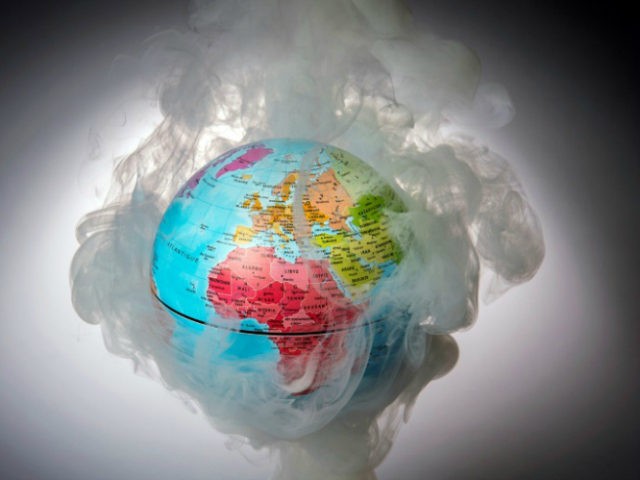The Lancet journal has joined the ranks of the most crazed climate propagandists, warning of a climate meltdown comparable to nuclear war.
In its review of David Wallace-Wells’ The Uninhabitable Earth: Life After Warming, the once prestigious medical journal underscores the extreme nature of the author’s predictions, only to insist that things are actually worse than what he describes.
Starkly titled “Climate Armageddon,” the nearly hysterical review by Lancet’s Laurie Garrett declares that just since 2017, when Wallace-Wells laid out his theories in an essay that forms the foundation for his book, “a number of record-breaking severe weather events, hastening melting of polar ice, rising sea temperatures, and the massive die-offs along Australia’s Great Barrier Reef have raised the tone of urgency among climatologists and earth scientists.”
Garrett oozes praise for Wallace-Wells’ “gorgeous command of the English language,” declaring that he “knows how to lay down prose that moves the reader at such a clip that one feels like a Kentucky Derby-exhausted mare at the end of each chapter.”
The real problem with the review, however, is not the author’s unrestrained adoration for her subject, but rather her own apocalyptic alarmism that goes beyond any scientific justification.
Garrett notes that Wallace-Wells “peppers” his book “with words like annihilation, Armageddon, extinction, and ‘existential crisis,’” and yet instead of taking him to task for overplaying his hand, Garrett proposes that he is entirely right and may, indeed, be underestimating the dangers of climate change.
“Like frogs that fail to leap from a slowly heating pot of water until they boil, humans seem to adapt to rising temperatures, evincing little alarm in the absence of personal catastrophe. But humans are simmering, and will increasingly be suffering,” Garrett states.
In a language reminiscent of Y2K scares of the late 1990s, Garrett cites studies suggesting that as a result of climate change, “food shortages, alone, could kill more than half a million people,” while “millions more could suffer lethal events due to everything from surges in mosquito populations to collapse of electrical power grids.”
The review reads, in fact, like an extended comparison between anthropogenic climate change and nuclear war. Garrett compares The Uninhabitable Earth to Jonathan Schell’s 1982 “masterpiece” on nuclear war, The Fate of the Earth, in which Schell observed that “the fruit of four and a half billion years can be undone in a careless moment.”
Likening nuclear fallout to the climatological impacts of major volcanic events, Schell and others suggested nuclear war would produce similar effects in which, “dust and smoke are generated and encircle the earth within 1 to 2 weeks, average light levels can be reduced to a few percent of ambient and land temperatures can reach −15° to −25°C,” Garrett says.
“This, they argued, would spawn a nearly uninhabitable world, caught in what they dubbed ‘Nuclear Winter,’” Garrett states.
“As was the case when Schell wrote of nuclear war, we now see the rising threats of climate change provoking responses from the scientific, medical, public health, political, and environmental communities,” Garrett insists.
A new generation of such apocalyptic writers must emerge in our own day, Garrett suggests, so that the fear of climate change will be for the present generation what the fear of nuclear war was for generations past.
The “real power” of arguments against nuclear war “was in compelling collective imagination, including at the highest levels of western and Soviet power, of the horror of ‘surviving’ thermonuclear weapons,” Garrett says, something the world needs to recapture in the present context.
Wallace-Wells himself sees “the parallels between the threat of nuclear war and climate change,” Garrett notes approvingly. “Nuclear Armageddon, in theory, has a few dozen authors; climate catastrophe has billions of them,” Wallace-Wells declares in his book.
And yet, if anything, Wallace-Wells does not take the comparison far enough, Garrett says.
“The parallels between nuclear weapons and devastation wrought by melting Greenland may, nevertheless, be tighter than Wallace-Wells acknowledges,” she warns.
Nonetheless, ultimately, Garrett is slightly more optimistic about the future than Wallace-Wells because where he sees only darkness on the horizon, she sees a glimmer of hope.
“Missing from most efforts to date, and from this book, is faith in the green grassroots, the Greta Thunberg generation, Earth Day marchers, America’s Green New Deal debates, and the cumulative impact of billions of steps towards a new world,” Garrett proposes.
Because, until “the world’s politically and financially powerful realise that failure to act boldly will get them unseated by their stockholders and citizenries, Wallace-Wells horribly dark vision of doom will prevail,” Garrett portends.
The fact that Rep. Alexandria Ocasio-Cortez’s (D-NY) Green New Deal can be put forward in a purportedly scientific journal as a program worthy of consideration shows to what depths the Lancet has fallen.
It is, however, much worse than that.
The Lancet has lent its once-venerable pages for an exercise in climate scare-blogging at its most irresponsible. If this is what passes for an academic review in the U.K.’s flagship medical journal, one can only mourn the death of serious medical journalism.
Follow Thomas D. Williams on Twitter Follow @tdwilliamsrome

COMMENTS
Please let us know if you're having issues with commenting.